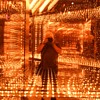Posted 11 years ago
 cogito
cogito
(123 items)
I've been chasing one of these for quite some time - an Adrien-Pierre Dalpayrat flambé stoneware double inkwell with pewter caps from the late 1890s, which may have been designed in conjunction with Edouard Colonna for retail at Julius Meier-Graefe's La Maison Moderne (Paris, Fr.). The curve of line and vivid colors of the glaze effects are prototypical of Dalpayrat's functional pieces. The well-placed double inkwells are preceded by a recessed tray/pen rest where the glaze has adapted spectacularly to the form and has pooled in a combination of green/blue and red. The underside is hand inscribed "Dalpayrat." Dimensions: 6.5” x 5.75” x 3.2”.
An example of this inkwell is found in "Adrien Dalpayrat: Franzosische Jugendstil-Keramik" (1998), Arnoldsche, Stuttgart; Pg. 166.
Ex-Bonhams; Ex-Jason Jacques Gallery; Ex-Rago Auction Gallery.
-----------------
Adrien-Pierre Dalpayrat (French, 1844–1910) was born in Limoges. As a youngster with an interest in painting and design, he attended a local art school and subsequently trained at the Limoges Municipal School of Porcelain Painting. In the first decades of his career, Dalpayrat was a faïence painter, working at six different manufactories between 1867 and 1888. In 1889, he settled down near Paris in Bourg-la-Reine, a town with a long history of porcelain manufacture. At around this time, he dropped the designation of 'porcelain painter' and began to identify himself as a 'ceramist' or 'artist-ceramist.' From that time forward, he devoted his time mostly to stoneware, a material revered for its Japanese associations and in vogue at the time given the published and popular review of Asian art by Sigfried Bing. Dalpayrat's studio executed objects by Maurice Dufrêne, designer of furniture, textiles, glassware, silverware, and ceramics. Dufrêne was the director and manager of La Maison Moderne, an association of artists who worked together to create designs that could be produced in multiples.
Dalpayrat was well known for his sang de boeuf (oxblood) flambé pottery, so much so that the term "Dalpayrat red" was coined to designate his distinctive glaze. Modeled after the oxblood glazes on Chinese pottery centuries earlier, Dalpayrat's version diverges in interesting and organic ways with swirls of color and irregular surface characteristics that perfectly encapsulates the French Art Nouveau aesthetic. Perfected by 1892, Dalpayrat unveiled his oxblood glaze at the prestigious Galerie Georges Petit in Paris, where he exhibited 50 stoneware pieces based on models by Alphonse Voisin-Delacroix. His success with the high fire glazed stoneware was immediate, and since that fateful exhibition, Dalpayrat has been recognized as a master of the art form and a key figure in French Art Nouveau pottery.










































Very nice!! Love the nouveau lids ;-)
Amazing glaze!
gorgeous
Thanks folks. This one makes me wish we still used dip pens and ink.
stunning!!
Oh yes very nice and a classic!
So beautiful, cogito!!!
wonderful colors